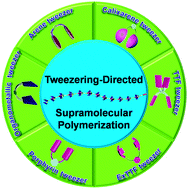当前位置:
X-MOL 学术
›
Chem. Soc. Rev.
›
论文详情
Our official English website, www.x-mol.net, welcomes your
feedback! (Note: you will need to create a separate account there.)
Donor–acceptor-type supramolecular polymers on the basis of preorganized molecular tweezers/guest complexation
Chemical Society Reviews ( IF 40.4 ) Pub Date : 2018-05-18 00:00:00 , DOI: 10.1039/c7cs00802c Yifei Han 1, 2, 3, 4, 5 , Yukui Tian 1, 2, 3, 4, 5 , Zijian Li 1, 2, 3, 4, 5 , Feng Wang 1, 2, 3, 4, 5
Chemical Society Reviews ( IF 40.4 ) Pub Date : 2018-05-18 00:00:00 , DOI: 10.1039/c7cs00802c Yifei Han 1, 2, 3, 4, 5 , Yukui Tian 1, 2, 3, 4, 5 , Zijian Li 1, 2, 3, 4, 5 , Feng Wang 1, 2, 3, 4, 5
Affiliation

|
The bottom-up self-assembly of donor–acceptor (D–A) units has received tremendous attention in recent years. Charge-transfer interactions, which are inherently embedded in D–A pairs, have suffered from some disadvantages such as erratic arrangements and weak binding affinity, thus hampering the precise arrangement of D–A units into long-range-ordered supramolecular polymers. To address this issue, a feasible protocol is to incorporate D–A units into molecular tweezers/guest recognition motifs, which concurrently feature high complexation directionality, strong binding affinity and stimuli-responsiveness. In this tutorial review, we have summarized the recent advances on the tweezering directed formation of D–A-type supramolecular polymers, with particular emphasis on the design principles of monomers and macroscopic behaviors of supramolecular polymers, together with future challenges in this research field.
中文翻译:

供体-受体型超分子聚合物在预组织的分子镊子/客体络合的基础上
近年来,自下而上的供体-受体(D-A)单元的自组装受到了极大的关注。固有地嵌入在D–A对中的电荷转移相互作用具有一些缺点,例如排列不规则和较弱的结合亲和力,从而妨碍了D–A单元向长程有序超分子聚合物的精确排列。为了解决这个问题,可行的方案是将D–A单元结合到分子镊子/客体识别基序中,同时具有高络合方向性,强大的结合亲和力和刺激响应能力。在本教程的复习中,我们总结了在镊子定向形成D–A型超分子聚合物方面的最新进展,
更新日期:2018-05-18
中文翻译:

供体-受体型超分子聚合物在预组织的分子镊子/客体络合的基础上
近年来,自下而上的供体-受体(D-A)单元的自组装受到了极大的关注。固有地嵌入在D–A对中的电荷转移相互作用具有一些缺点,例如排列不规则和较弱的结合亲和力,从而妨碍了D–A单元向长程有序超分子聚合物的精确排列。为了解决这个问题,可行的方案是将D–A单元结合到分子镊子/客体识别基序中,同时具有高络合方向性,强大的结合亲和力和刺激响应能力。在本教程的复习中,我们总结了在镊子定向形成D–A型超分子聚合物方面的最新进展,











































 京公网安备 11010802027423号
京公网安备 11010802027423号